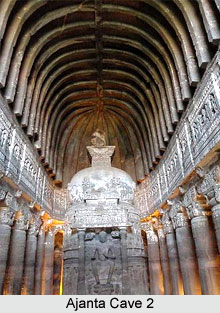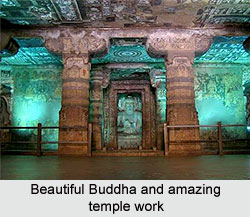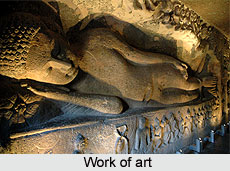 Ajanta Cave 2, somewhat looks like Ajanta Cave 1, almost looks like a monastery, though smaller in dimensions, is somewhat similar to Cave 1. At either end of the verandah is a small cell with a pillared porch in front, the architrave above the pillars being divided into three panels. The central compartment on the right porch is carved with a seated naga king and his attendants, while the side-ones are relieved with pot-bellied yakshas, the right one being the Buddhist counterpart of Kubera. The central figure on the facade of the left porch is probably Hariti, as she has got a child on her lap. The pillars of the verandah differ from those of Cave 1. They have moulded bases, the tapering shafts changing from sixteen sides to thirty-two flutes, relieved by belts of tracery and surmounted by a capital having two lotuses with an amalaka-like object in between. A richly-carved doorway, flanked by a decorated window on either side, gives access to the pillared hall.
Ajanta Cave 2, somewhat looks like Ajanta Cave 1, almost looks like a monastery, though smaller in dimensions, is somewhat similar to Cave 1. At either end of the verandah is a small cell with a pillared porch in front, the architrave above the pillars being divided into three panels. The central compartment on the right porch is carved with a seated naga king and his attendants, while the side-ones are relieved with pot-bellied yakshas, the right one being the Buddhist counterpart of Kubera. The central figure on the facade of the left porch is probably Hariti, as she has got a child on her lap. The pillars of the verandah differ from those of Cave 1. They have moulded bases, the tapering shafts changing from sixteen sides to thirty-two flutes, relieved by belts of tracery and surmounted by a capital having two lotuses with an amalaka-like object in between. A richly-carved doorway, flanked by a decorated window on either side, gives access to the pillared hall.
The pillars, twelve in number, are decorated in the manner of those of the hall of Cave 1, the central pillars of the front and back rows having the minute carvings to the point of over-ornamentation. There are ten cells on two of its sides. The back wall of the shrine is carved with the figure of Buddha in teaching attitude flanked by chamara-bearers, the left one being Padmapani. The door of the shrine and the pillars and pilasters of the antechamber are profusely ornamented. Projecting from the base of the capitals of the central pillars of the antechamber and supporting the architrave are bracket-figures of nayikas with attendants.
On the pedestal is an interesting group starting from the right one can find three attentive boys engaged in writing before a teacher admonishing them with a cudgel; next two boys are boxing; and lastly, a group of five boys is goading two rams to fight -a realistic representation of the ubiquitous backbenchers and truants.
The left chapel has two corpulent yakshans attended by chamara-bearers. Most interesting is the luxuriant crop of their curly tresses falling on one side, a type of coiffure very common in the sculptures of Ajanta. The cover-up of these chapels is relieved with groups of figures in compartments. The cave contains a number of painted records, though fragmentary.
The cave is remarkable for the survival of most of the ceiling-paintings of the hall, antechamber, shrine, chapels and verandah with side-porches. Like Ajanta Cave 1, the painting on the ceiling takes the form of compartments filled in with a variety of designs, including floral patterns, birds, fruits, flying figures, fantastic and comic figures and geometric and ornamental motifs. The colour-schemes, however, are different. The central panels are square and are much larger than the others; their subject is also different. Here one can find painted bands of concentric circles with spandrels filled in with different motifs, of which the flying figures are exquisitely rendered. The painting on the ceiling of the shrine is one of the best specimens of the painter`s art at Ajanta.
 The side-walls of the shrine, walls of the antechamber, part of the left wall of the hall and left half of the back wall, all painted with countless Buddhas in various attitudes. Also painted here are three large-sized Bodhisattvas, one on the back wall of the hall and two on the front wall of the shrine. Of the latter, the one to the left of the doorway does not represent Maitreya, but is actually Avalokitesvara in the role of the saviour of mankind threatened with the Eight Great Perils of lion, elephant, fire, snake, robber, water, fetters and demon.
The side-walls of the shrine, walls of the antechamber, part of the left wall of the hall and left half of the back wall, all painted with countless Buddhas in various attitudes. Also painted here are three large-sized Bodhisattvas, one on the back wall of the hall and two on the front wall of the shrine. Of the latter, the one to the left of the doorway does not represent Maitreya, but is actually Avalokitesvara in the role of the saviour of mankind threatened with the Eight Great Perils of lion, elephant, fire, snake, robber, water, fetters and demon.
Of the scenes from the life of Buddha, the nativity is painted on the left wall of the hall between the front pilaster and the third cell-door. The bottom left panel, though much damaged, depicts the bedchamber of Maya, who dreamt of a white elephant entering her body. The elephant, the form in which Bodhisattva alighted from the Tushita heaven, is not very clear in the panel, as the portion has suffered much. Above the panel is a royal couple -apparently Maya relating her dream to her husband Suddhodana.
The next top panel above the cell-door has been interpreted as the Tushita heaven, the abode of Bodhisattva before his descent. The princely figure, with an aureole around his head and seated in the teaching attitude, is Bodhisattva. The panel to its right relates to the interpretation of Maya`s dream. When Maya related her dream to the king, he sent for the Brahmanas, who declared that the queen had conceived a son destined to become either a universal monarch (chakravartin) or a Buddha. Next, one can find a beautiful princess, apparently Maya {who was believed to have been protected during gestation from all harms by celestials), standing in a pensive mood between two pillars. Below is shown the birth of Buddha: Sakra holds the new-born babe in his arms, while Maya stands holding the branch of a tree. The seven steps, which Gautama took immediately, afterwards are painted to the right of this. The lowest part of the panel has the appearance of having been left unfinished.
Inside Ajanta Cave 2 the following Jatakas are identified. On the extreme left wall of the hall is depicted the Harhsa jataka (no. 502). Queen Khema having seen in her dream a golden goose discoursing the law to her, the king of Varanasi made a decoy-lake, and his fowler succeeded in capturing the golden goose-king (Bodhisattva) and his faithful captain, Sumukha. Both of them were brought to the presence of the royal couple who were satisfied with the discourse and set them free. In the lower panel to the left of the cell- door, the fowler along with an official is seen approaching the geese in a lotus-lake. A little above, the fowler is going out of the lake after catching hold of the geese. In the top panel the golden goose, seated on a throne, is delivering the sermon to the royal couple. The next scene above the cell is laid in the king`s court where Bodhisattva is seen preaching to an assembly-Lower below, to the right of the door, is a lake full of lotuses and lilies in all possible stages of bloom, among which is seen the golden goose.
 The Vidhurapandita jataka (no. 545) occupies a large portion of the right wall of the hall. On the right half of the composition can be seen Irandati on a swing, Punnaka meeting Irandati and the naga king consulting his kinsmen over Purmaka`s proposal of marrying his daughter, while in the left half are depicted the audience-chamber of the king of Indraprastha, the game of dice, Vidhurapandita`s journey with Punnaka, the former`s discourse in the naga king`s palace and the happy union. Delineated below the Vidhuraparidita jdiaka, where Irandati is on a swing, is the Purna Avadana. In the bottom left we find Purna in front of Buddha signifying his conversion. To the right is a boat in danger, and its owner, apparently Bhavila, the brother of Purna, praying for succour, in response to which an angel, followed by a monk, apparently Purna, as narrated in the Avadana, comes to his rescue.
The Vidhurapandita jataka (no. 545) occupies a large portion of the right wall of the hall. On the right half of the composition can be seen Irandati on a swing, Punnaka meeting Irandati and the naga king consulting his kinsmen over Purmaka`s proposal of marrying his daughter, while in the left half are depicted the audience-chamber of the king of Indraprastha, the game of dice, Vidhurapandita`s journey with Punnaka, the former`s discourse in the naga king`s palace and the happy union. Delineated below the Vidhuraparidita jdiaka, where Irandati is on a swing, is the Purna Avadana. In the bottom left we find Purna in front of Buddha signifying his conversion. To the right is a boat in danger, and its owner, apparently Bhavila, the brother of Purna, praying for succour, in response to which an angel, followed by a monk, apparently Purna, as narrated in the Avadana, comes to his rescue.
The theme of the painting on the right wall of the front aisle above the cell-door cannot be made out, as it has suffered great damages. The kneeling figure of the lady beseeching for mercy, an angry king who is brandishing his sword, is a masterpiece of Indian painting.
The paintings on the walls of the chapels are remarkably well-preserved. Although the subject-matter in both the chapels is almost the same, viz., lady votaries bringing offerings, their treatment, colour-scheme and background are entirely different from each other. The compositions on the walls of the Hariti chapel are laid amidst a rocky landscape.



















